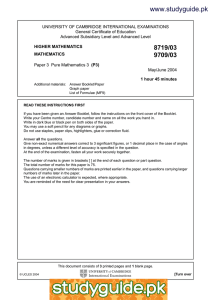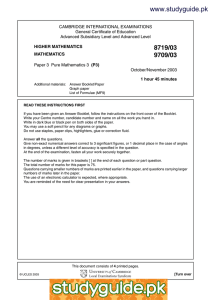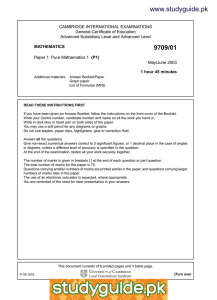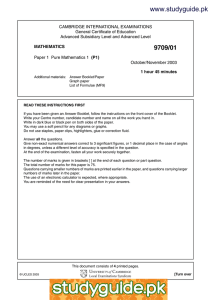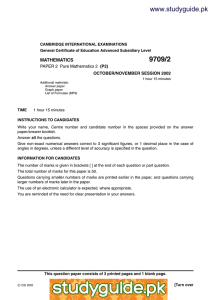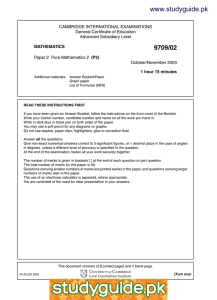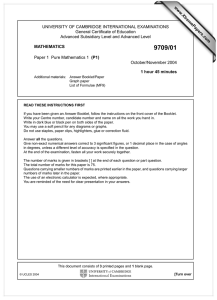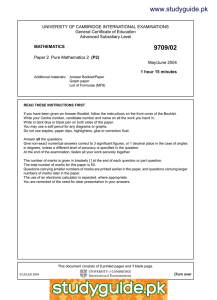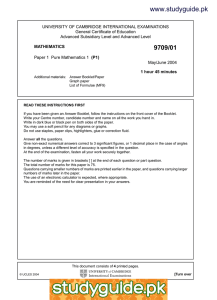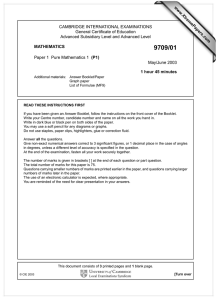www.studyguide.pk
advertisement
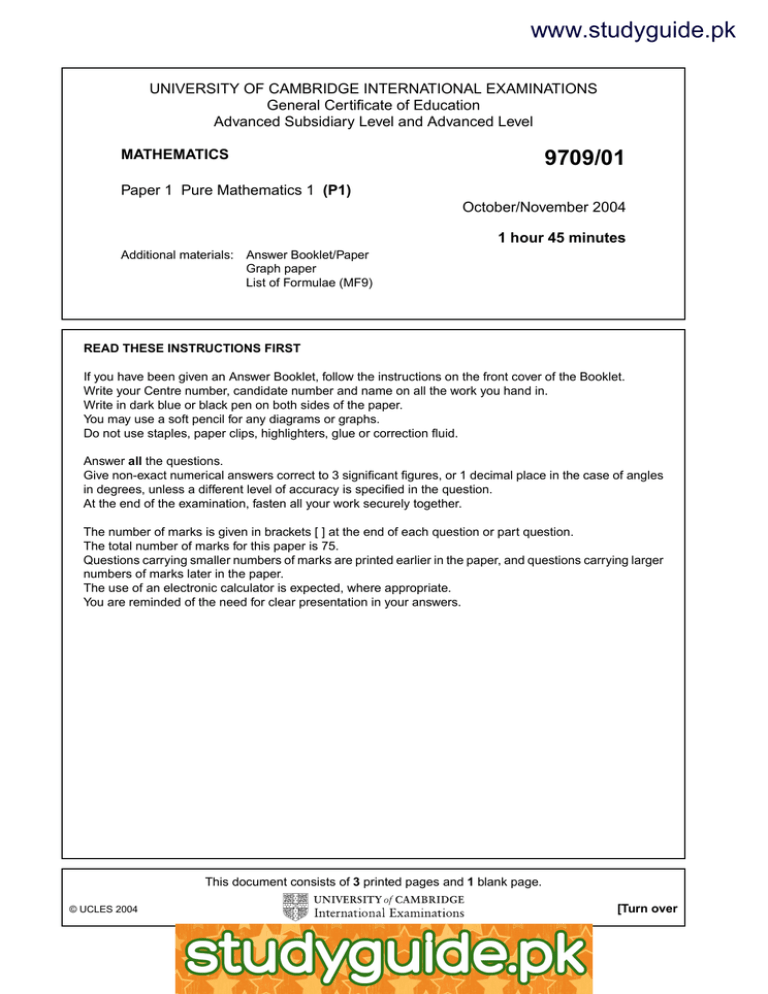
www.studyguide.pk UNIVERSITY OF CAMBRIDGE INTERNATIONAL EXAMINATIONS General Certificate of Education Advanced Subsidiary Level and Advanced Level MATHEMATICS 9709/01 Paper 1 Pure Mathematics 1 (P1) October/November 2004 1 hour 45 minutes Additional materials: Answer Booklet/Paper Graph paper List of Formulae (MF9) READ THESE INSTRUCTIONS FIRST If you have been given an Answer Booklet, follow the instructions on the front cover of the Booklet. Write your Centre number, candidate number and name on all the work you hand in. Write in dark blue or black pen on both sides of the paper. You may use a soft pencil for any diagrams or graphs. Do not use staples, paper clips, highlighters, glue or correction fluid. Answer all the questions. Give non-exact numerical answers correct to 3 significant figures, or 1 decimal place in the case of angles in degrees, unless a different level of accuracy is specified in the question. At the end of the examination, fasten all your work securely together. The number of marks is given in brackets [ ] at the end of each question or part question. The total number of marks for this paper is 75. Questions carrying smaller numbers of marks are printed earlier in the paper, and questions carrying larger numbers of marks later in the paper. The use of an electronic calculator is expected, where appropriate. You are reminded of the need for clear presentation in your answers. This document consists of 3 printed pages and 1 blank page. [Turn over © UCLES 2004 www.xtremepapers.net www.studyguide.pk 2 1 2 5 Find the coefficient of x in the expansion of 3x − . x 2 Find [4] (i) the sum of the first ten terms of the geometric progression 81, 54, 36, . . . , [3] (ii) the sum of all the terms in the arithmetic progression 180, 175, 170, . . . , 25. [3] 3 In the diagram, AC is an arc of a circle, centre O and radius 6 cm. The line BC is perpendicular to OC and OAB is a straight line. Angle AOC = 13 π radians. Find the area of the shaded region, giving √ [5] your answer in terms of π and 3. 4 (i) Sketch and label, on the same diagram, the graphs of y = 2 sin x and y = cos 2x, for the interval [4] 0 ≤ x ≤ π. (ii) Hence state the number of solutions of the equation 2 sin x = cos 2x in the interval 0 ≤ x ≤ π . [1] 5 The equation of a curve is y = x2 − 4x + 7 and the equation of a line is y + 3x = 9. The curve and the line intersect at the points A and B. (i) The mid-point of AB is M . Show that the coordinates of M are 12 , 7 12 . [4] (ii) Find the coordinates of the point Q on the curve at which the tangent is parallel to the line y + 3x = 9. [3] (iii) Find the distance MQ. 6 [1] The function f : x → 5 sin2 x + 3 cos2 x is defined for the domain 0 ≤ x ≤ π . (i) Express f(x) in the form a + b sin2 x, stating the values of a and b. [2] (ii) Hence find the values of x for which f(x) = 7 sin x. [3] (iii) State the range of f. [2] 9709/01/O/N/04 www.xtremepapers.net www.studyguide.pk 3 7 A curve is such that dy 6 =√ and P (3, 3) is a point on the curve. dx (4x − 3) (i) Find the equation of the normal to the curve at P, giving your answer in the form ax + by = c. [3] (ii) Find the equation of the curve. 8 [4] The points A and B have position vectors i + 7j + 2k and −5i + 5j + 6k respectively, relative to an origin O. (i) Use a scalar product to calculate angle AOB, giving your answer in radians correct to 3 significant figures. [4] −−→ −−→ −−→ (ii) The point C is such that AB = 2BC. Find the unit vector in the direction of OC. 9 [4] The function f : x → 2x − a, where a is a constant, is defined for all real x. (i) In the case where a = 3, solve the equation ff(x) = 11. [3] The function g : x → x2 − 6x is defined for all real x. (ii) Find the value of a for which the equation f(x) = g(x) has exactly one real solution. [3] The function h : x → x2 − 6x is defined for the domain x ≥ 3. 10 (iii) Express x2 − 6x in the form (x − p)2 − q, where p and q are constants. [2] (iv) Find an expression for h−1 (x) and state the domain of h−1 . [4] 2 A curve has equation y = x2 + . x dy d2 y (i) Write down expressions for and 2 . dx dx [3] (ii) Find the coordinates of the stationary point on the curve and determine its nature. [4] (iii) Find the volume of the solid formed when the region enclosed by the curve, the x-axis and the [6] lines x = 1 and x = 2 is rotated completely about the x-axis. 9709/01/O/N/04 www.xtremepapers.net www.studyguide.pk 4 BLANK PAGE 9709/01/O/N/04 www.xtremepapers.net
